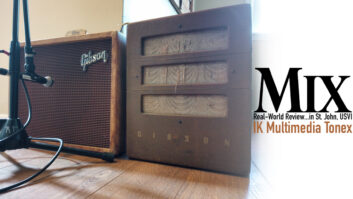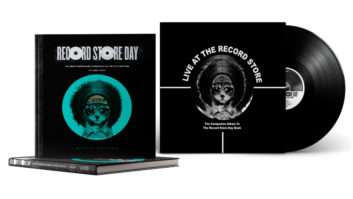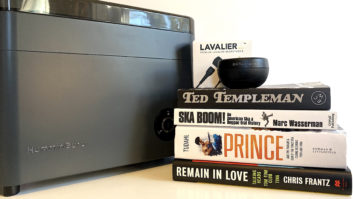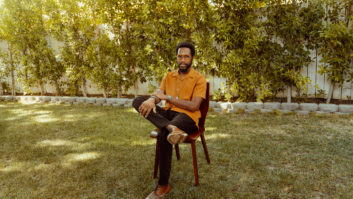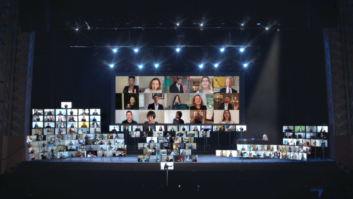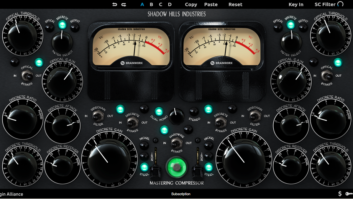Just as millions of Americans have come to believe that “You can have it all,” in our industry the new mantra is, “You can do it all.” It’s hard to open a magazine, go into a music store or get through the security gates at a trade show without being bombarded by this-is-all-you-need workstations and software from Pro Tools to Garage-Band. And it’s true that what you can buy these days for very short money is absolutely mind-boggling and — this month bringing Summer NAMM — it’s about to become more so. In a couple of weeks in Nashville, the art and science of stuffing more functionality into smaller, cooler-looking and cheaper packages will no doubt take yet another quantum leap.
Of course, the one-man-band recording concept is nothing new. When Les Paul invented multitracking, he didn’t do it for a band, he did it for himself. On Paul McCartney’s first solo album, the former Beatle played all of the instruments by himself. Part of the draw of electronic music from its earliest days was that the composer had complete control over the finished product. I first tried it during my freshman year of college: To get out of writing a term paper on William Blake for an English class, I set a bunch of his poems to music and wired two stereo tape recorders together so I could layer several instruments and sing harmony with myself. A few years later, while on a mercifully brief songwriting binge, I walked into a high-end 8-track studio in New York with all of the money I could scrounge up and managed to come out with a pretty decent four-song demo on which, like McCartney, I overdubbed all of the instruments: guitars, bass, keyboards and even drums. Unlike McCartney, however, my efforts went nowhere.
It was when cheap “semi-pro” multitracks came along that the cost of entry to the solo private studio fell off its first cliff. Multitrack hard disk audio was another milestone, and the fall off that cliff continues to accelerate as hard disk space keeps getting cheaper. How’s this for a statistic: Between 1984, when I bought my first 20-megabyte hard drive for $1,200, and last week, when I bought a 120-gigabyte hard drive for $120, the cost of random-access digital storage has gone down 99.99833 percent!
MIDI had its role in promoting the one-person-orchestra concept, as you didn’t need the actual instruments anymore. But there was still a cost factor: When Yamaha first ruled the synth world, if you needed multiple FM voices, then you bought multiple DX7 keyboards at $2,000 or so apiece. But pretty soon, you could get a TX816 rack, saving more bucks and space. Then, manufacturers figured out how to make multitimbral synths that could take the place of 16 or 32 modules. Since then, synths and processors have shrunk to the point where they take up literally no space at all. As the pundits at Wired magazine like to put it, they’re made of electrons, not atoms.
Then there’s the peripheral hardware. Who could have foreseen the day when producers would pass the time on a transcontinental flight editing their next album on a computer on their lap? The world of education has been affected just as much: Only five years ago, when I would do any kind of a talk on music and multimedia, I’d have to take a car. That’s because I needed a desktop computer stuffed with PCI audio and sampler cards, a CRT monitor, a full-size keyboard synth, a video deck and a SMPTE synchronizer.
Now I can take a plane or a subway (or in the case of this month’s MacWorld Expo — which is back in Boston for the first time in seven years and happens to land right in the middle of my vacation on Cape Cod — on a ferryboat) with only my lowly iBook in tow. The synths and samples are in a Reason patch, the audio comes out of the computer’s headphone jack (if the audience is really picky, I can schlep a Mark of the Unicorn 828, which weighs 25 percent less than the iBook), and the video is a QuickTime movie that syncs up perfectly in Digital Performer without a SMPTE bit to be found anywhere. All I need are audio and video patch cords and I’m in business.
In my home studio, I still have three VCRs and as many CRTs, two mixers and four racks of hardware modules, but a lot of that stuff is not getting very much use. I could take that same iBook (which is already three years old but still kicks butt) and add one of the new, cheap, but highly functional MIDI/USB keyboard/control surfaces, a couple of much-better-than-you’d-expect-at-the-price Chinese large-diaphragm condenser mics and an inexpensive FireWire audio interface (they’re finally here!) with S/PDIF I/O and not-at-all-bad mic pre’s and end up with a pretty darn good little production facility that can be thrown, with room for cables and stands, into a carry-on suitcase. And the total cost would be less than any 8-track deck that was ever made — or my first Mac.
The studio-in-a-box is now so common that it’s hard to imagine that there was a time, not so long ago, when top-selling acts would agonize over the decision to build their own studio: Would the investment be justified by the money they’d save not making their next two or three albums somewhere else? Now that formula seems ludicrous: What I spent on that four-song demo in the ’70s was more — in 1970s dollars — than I would need to spend in today’s dollars to get a computer-based rig that could blow the socks off of anything I could have done in that studio.
So, obviously, this is the end of the recording industry as we know it, right? Well no, not yet, because most of us, it seems, are still working. And just as “You can have it all” is but a propaganda slogan as opposed to a practical way of life (you can’t, for example, have a functioning government with no taxes, and you can’t have peace in the Middle East with two SUVs in every garage), “You can do it all” is a nice way to sell toys, but it falls short in reality.
It’s true that thanks to products like Absynth, Kontakt and Reason, you can load up racks and racks of the most sophisticated synthesizers you could ever imagine. With GigaSampler, you can have at your disposal entire virtual symphony orchestras that are capable of making nearly every individual and collective sound that a real symphony can make. With Synthogy’s new Ivory virtual instrument, you can have a $175,000 9½-foot Bösendorfer Imperial Grand piano, beautifully recorded in an exquisite hall, at your beck and call. (Full Disclosure Department: I’m currently helping this company with its documentation.)
And it’s true that tools like Sonar, Deck, Nuendo and Digital Performer have made entry into the world of high-end production a lot easier. To take advantage of what these products have to offer, you no longer have to know how to handle a soldering iron, or which end of an electrolytic capacitor is which, or even how to gain-stage a mixer to keep the signal comfortably between the noise and the distortion. But the fact is, the greatest tools in the world are no good if you don’t know how to use them. And what you do have to know, and which no computer by itself can teach you, is music.
If you don’t know how a guitar is played, you can’t possibly take advantage of even the greatest virtual guitar software. If you’ve never sat in a horn section, or at least written music for one and heard it played by real players, then you can’t do a convincing simulation of one with a keyboard, no matter how brilliant the samples are under your fingers. And if you don’t play the piano and have never learned about dynamics, phrasing and pedaling, any piano track you come up with is likely to be mechanical and boring.
Learning how to work with music without knowing about music itself is extremely difficult and no fun. In traditional college recording programs, teachers all agree that it’s generally much easier to teach engineering and studio techniques to a musician than it is to teach music to an engineer. Unless you’re planning to give up all originality and spend the rest of your musical career using other people’s samples and loops (yes, I know there are such people and I feel very sorry for them), you have to know how music is made, played and structured. And the best way to know that is to be a player.
With not many exceptions, the folks who are behind the records that make the top of the charts, who will be remembered after they drop off the charts and who win Grammy® and TEC Awards, have a real grounding in real music. Superhot rap producers The Neptunes met in a high school band class. Shania Twain didn’t learn how to sing from a machine. Bob Clearmountain and Bruce Swedien were both into electronics and recording at a very early age, but Clearmountain was also a bass player, and both of Swedien’s parents were professional musicians, so he grew up surrounded by the Minneapolis Symphony. Nile Rodgers is one of the greatest all-around producers in history, but before that, he was a killer guitar player. Meredith Brooks started playing guitar at the age of 11 and worked hard in bands for 25 years before she made Blurring the Edges, the first album on which she sang and played everything. And me? I played 11 different instruments in high school, some of them not too badly, in rock bands, folk groups, jazz combos, stage bands, orchestras, chamber groups and percussion ensembles. When I lay down a saxophone line, whether it’s on my VL1 or in Reason, I not only know what a saxophone is supposed to sound like, I know what it feels like.
On the other side of the coin, while the one-person studio has been so empowering for people like me, something has been lost. When I used to play in bands, as annoying and frustrating as I often found my bandmates, I never ran out of ideas. There was always something else somebody wanted to try. Nowadays, working by myself, composer’s block seems like a constant threat. If I don’t at least get out of my studio occasionally to see how someone else responds to what I’m creating, I can feel the creative juices drying up. If I don’t play with other musicians at least once in awhile — and it hardly matters whether I’m playing Dave Brubeck, Neil Young or four-hand piano arrangments of Mendelssohn symphonies — I feel like what I’m doing lacks context and my muse gets lethargic. That recharging I get from interacting with other musicians, even if it’s just a few times a year, is critical.
More than other musicians, though, it’s the audience we need. When I was a kid, I saw a terrific stage show performed by the great actress Mary Martin called It Takes Three to Make Music, the premise of which was that someone has to write it, someone else has to play it and someone has to listen to it. (The recording of this show won a Grammy in 1959, but you can’t get it on CD.) Of course, that equation has been slimmed down a bit in the intervening years, now that so many of us are taking care of the entire composition and performance chain. But we still need someone to listen to what we do or it isn’t music.
As I write this, an interesting event is unfolding in Vienna called Internethausmusik. It’s a performance project, sponsored by companies like IBM and Telekom Austria, in which 23 classical musicians sit in their apartments and “phone in” their parts (over Telekom DSL lines, of course) to a theater downtown, where a “conductor” mixes the parts and streams the result to the world. The musicians, the conductor and the audience are never in the same place at the same time.
The music that’s being played is designed specifically for this occasion, and in that context, it may work pretty well. But the publicity surrounding the event is hinting strongly that this might be a wave of the future: Instead of dealing with large, expensive concert halls where musicians meet to play, we can have them all sit at home with cheap microphones and Internet hook-ups playing their parts individually, leaving it up to a central conductor/engineer to make it all come together.
Of course, it’s ridiculous to apply this concept to any kind of traditional music for any number of reasons. First is timing. For musicians to make sense out of their ensemble, they have to hear each other in real time or be playing against pre-recorded tracks that they can lock up to. But even the fastest Internet connection is going to have enough latency — what with codecs, packet-switching and repeaters — to make it impossible for the musicians to hear each other in any way that they can possibly relate to.
A second reason is that there are no extra aural cues. Musicians constantly play off of each other visually, using facial gestures, eye contact, hand signals, and limb and body movements, both conscious and unconscious. It’s why drum booths have windows. Cutting players — especially classical players — off from each other’s sight completely would require a pretty major re-adjustment on everyone’s part.
But perhaps the most serious problem with creating this kind of bodiless music is that it insulates the musicians from their audience. The vast majority of us do this music thing because we want to communicate with people. We have ideas, emotions and concepts that we want to get across. Isolation, whether it’s sitting in front of a computer putting together beats and tracks and sending them out to faceless CD buyers, or playing into a glorified telephone along with others, whom you can’t hear, to an invisible Internet audience, is antithetical to what music is supposed to be about. Without each other and our audiences, we might as well be staring into a mirror 24 hours a day. Some narcissistic types might find that fascinating for a little while, but for most of us, it gets pretty old, pretty fast. Maybe you can have it all — but it doesn’t mean anything if you don’t share it.
As a child, Paul Lehrman was never warned not to play with himself and just look what it led to.
